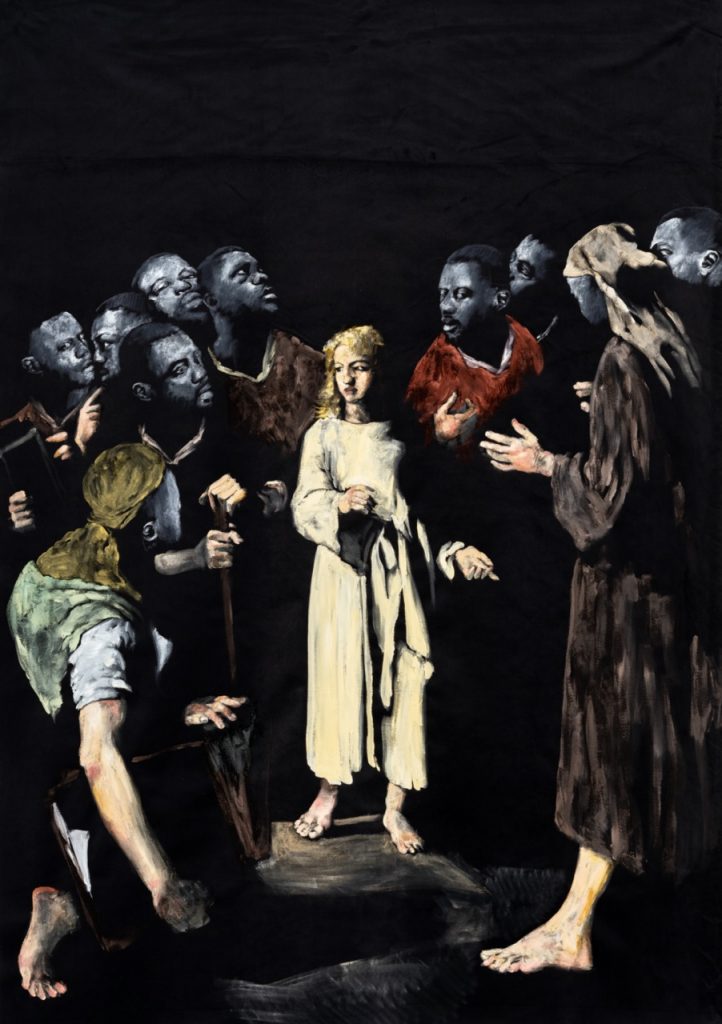D’APRÈS JESUS ET LES DOCTEURS | ROMÉO MIVEKANNIN
Black is the dominant color in the work of Roméo Mivekannin, an artist originally from Benin who later completed his studies in France.
A seductive and enveloping black, like the fabric on which the paintings are created, evoking a pleasant and relaxing sensation in deliberate contrast to the subjects of the compositions they support.
D’après Jesus et les docteurs is a reproduction of a famous 19th-century painting (housed in the Musée d’Orsay collection), which Mivekannin reproduces as a diptych—or rather, as a mirrored self-portrait. The artist’s face replaces the ethereal and childlike face of the original painting, intentionally dissonant in posture and proportions, with a determined and penetrating gaze. The effect is that of an intentionally rough superimposition in the technique, which leads, guides, or rather forces the viewer’s attention to that face and that detail of the painting.
Pictorial citation is certainly not an unusual practice in contemporary painting, even when combined with the use of personal archive material or biographical data. However, Mivekannin, through the meticulous and almost obsessive repetition of his own face, manages to make this practice a coherent and convincing stylistic hallmark.
A practice that should not be understood as self-assertion but rather as a means to make personal exploration explicit; Mivekannin employs symbols and representations from Western history, reinterpreting them through his own historical perspective in an attempt to dismantle an iconography that has assigned marginal roles to both female figures and enslaved people.
An assertive but not absolute reappropriation of the scene, the fluidity of the painting’s support material—the velvet—and the choice to present it without a frame or stretcher, thus giving it an intrinsic and uncontrolled movement, is part of the redefinition process that the artist intends to initiate—or rather, provoke.
Jesus or les docteurs are the same person yet at the same time their opposite: the inversion, the subversion of roles and power dynamics is a gesture the artist executes with awareness and precision through the didactic, yet effective mirrored dimension made explicit in the paintings. In the mirror, it is clearly the artist, but also us with him.
The work is currently on display at the Collezione Maramotti as part of Black Mirror, the first solo exhibition in Italy by Roméo Mivekannin. For this occasion, he has conceived a cohesive body of new paintings. The exhibition features around twenty large-scale paintings on black velvet, drawing from Mivekannin’s vast iconographic universe, enriched by inspirations gathered during his visits to Emilia-Romagna and his connection to the Italian artistic and cultural space.
Roméo Mivekannin
Black Mirror
Collezione Maramotti
Until July 27, 2025
Collezione Maramotti
Roméo Mivekannin
D’après Jésus et les docteurs, Théodule Ribot (1879)
2024
acrylic on black velvet, 200 x 140 cm
© Roméo Mivekannin, by SIAE 2025
Courtesy of the artist and Galerie Cecile Fakhoury (Abidjan, Dakar, Paris)
Ph. Gregory Copitet

Roméo Mivekannin, D’après Jésus et les docteurs, Théodule Ribot (1879), 2024
acrylic on black velvet, 200 x 140 cm
© Roméo Mivekannin, by SIAE 2025
Courtesy of the artist and Galerie Cecile Fakhoury (Abidjan, Dakar, Paris)
Ph. Gregory Copitet
05/04/2025

